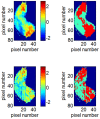Quality coding by neural populations in the early olfactory pathway: analysis using information theory and lessons for artificial olfactory systems
- PMID: 22719851
- PMCID: PMC3377695
- DOI: 10.1371/journal.pone.0037809
Quality coding by neural populations in the early olfactory pathway: analysis using information theory and lessons for artificial olfactory systems
Abstract
In this article, we analyze the ability of the early olfactory system to detect and discriminate different odors by means of information theory measurements applied to olfactory bulb activity images. We have studied the role that the diversity and number of receptor neuron types play in encoding chemical information. Our results show that the olfactory receptors of the biological system are low correlated and present good coverage of the input space. The coding capacity of ensembles of olfactory receptors with the same receptive range is maximized when the receptors cover half of the odor input space - a configuration that corresponds to receptors that are not particularly selective. However, the ensemble's performance slightly increases when mixing uncorrelated receptors of different receptive ranges. Our results confirm that the low correlation between sensors could be more significant than the sensor selectivity for general purpose chemo-sensory systems, whether these are biological or biomimetic.
Conflict of interest statement
Figures








References
-
- Gardner JW, Bartlett PN. A brief history of electronic noses. Sensors and Actuators B: Chemical. 1994;18:210–211.
-
- Fonollosa J, Gutierrez-Galvez A, Lansner A, Martinez D, Rospars JP, et al. Biologically Inspired Computation for Chemical Sensing. Procedia Computer Science. 2011;7:226–227.
-
- Barlow HB. Possible principles underlying the transformation of sensory messages. Sensory Communication MIT Press. 1961. pp. 217–234.
-
- Vassar R, Chao SK, Sitcheran R, Nunez JM, Vosshall LB, et al. Topographic organization of sensory projections to the olfactory-bulb. Cell. 1994;79:981–991. - PubMed

